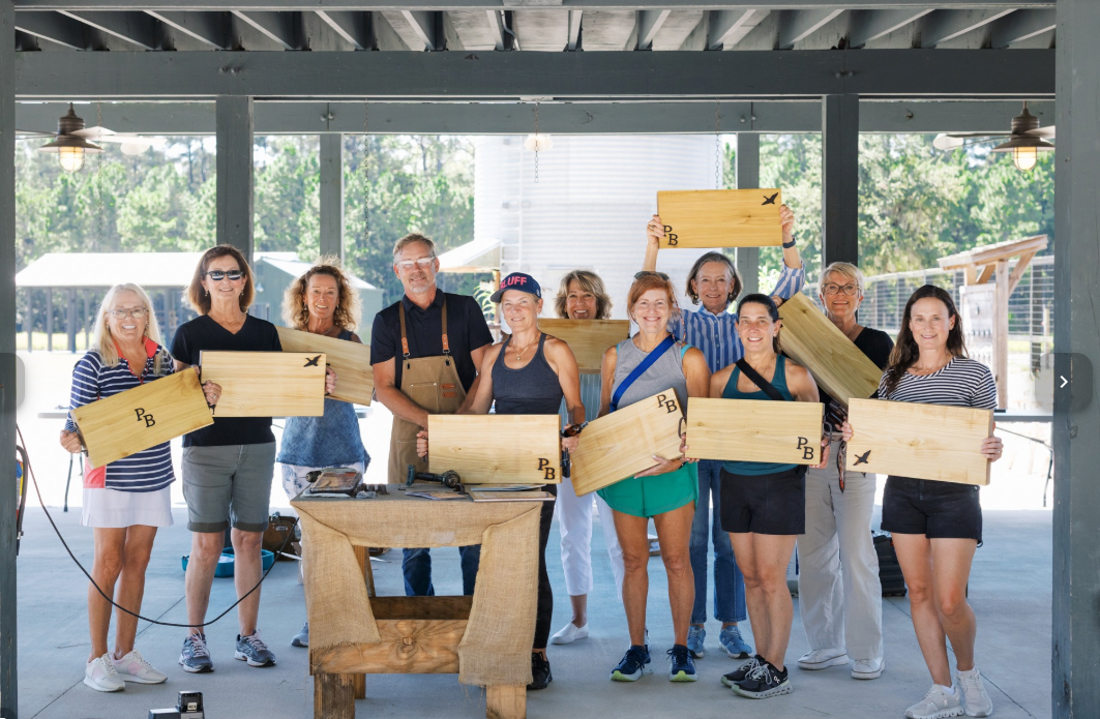Palmetto Bluff Real Estate Company Sales Office
Office Hours
Monday-Friday 9am - 5pm
Saturday 9am - 4pm
Sunday 12 - 4pm
Saturday 9am - 4pm
Sunday 12 - 4pm
How do you study bats?
There are two major methods for studying bats: catching them in nets or recording them with acoustic devices. Netting bats produces a small amount of extremely detailed information, while recording bats provides a large amount of comparatively broad information. In a future post, we will cover studying bats using acoustic methods, but here we will focus on how we capture bats in nets.
When I tell people that I catch bats with mist nets, they often confess they picture me standing in a field with a large butterfly net, waiting for a bat to get close. While this would be an impressive feat, that is not the kind of net we use to capture bats.
Instead, we extend large, polyester mesh nets – called mist nets- across corridors used by bats. The nets are connected to poles on either side, which keep the nets taut. On each pole is a pulley system that allows us to lower the net when we catch a bat so we can remove it safely. We often stack nets on top of each other to increase the height of our vertical trap. For example, a triple-high net is three nets stacked on top of each other. Each net is 2.6m tall, so a triple-high net is 7.8m tall and allows us to catch bats flying high above the ground.

The mesh is thin and difficult to see (trust me! I have walked into my own nets more times than I would like to admit). While we
may have a difficult time seeing the net, bats can detect nets in two ways. They can see mist nets with their eyes – particularly when the moon is bright or the net is in the open – AND they can detect nets with echolocation. This makes bats extremely difficult to catch!
We try to get around this by placing nets in a way that funnels bats into the net. The idea is that, by the time a bat has detected the net, there is not a way for them to fly around it. We meticulously erect our nets in the best part of the corridor, or flyway, that provides an optimal funnel. An ideal net setup has trees and bushes along the sides, preventing bats from flying around the net, as well as overhanging branches covering the top. The overhanging branches force the bat to drop down and fly under the branches while obscuring the top of the net. Ideally, this keeps bats from being able to fly over the net, but it is by no means foolproof! Bats are incredible fliers and are maddeningly successful at cutting away from a net at the last minute. Essentially, we are catching the bats that are not paying attention.

All 13 species of bat documented in Beaufort County have the sharp teeth required to slice through insect exoskeletons. Unfortunately, those same sharp teeth help bats chew their way out of mist nets. After we open our nets at sunset, we check them every 7 minutes to make sure we remove bats before they chew their way out and to prevent bats from getting too tangled and hurting themselves.

Once we have removed a bat from the net, we process it using a standardized protocol. We weigh each bat and identify its species, sex, and reproductive condition. For males, we inspect their genitals to see if they are reproductive or nonreproductive. For females, assessing the reproductive condition allows us to document whether they are pregnant, nursing pups, or have nursed pups in the last few months. We palpate the female’s abdomen to see if her stomach feels full and hard – two good indications she is pregnant. Each species of bat has a specific weight range, so her weight gives us information about pregnancy too; if she is on the heavier side of her species’ range, there is a good chance she is pregnant and her weight is reflecting the weight of her pup. If she is not pregnant, we inspect her nipples to see if she is producing milk or has lost a ring of fur right around her nipples. While the pups are suckling, they remove a ring of fur around the female’s nipple that lasts about a month or so after the pup has weaned before the fur eventually grows back. If we catch a bat that is no longer producing milk but is missing a ring of fur around her nipple, we know she is “post-lactating” and had a pup earlier in the year.

After assessing reproductive condition, we measure the length of the right forearm before inspecting the wings for damage and scarring. We also determine if a bat is an adult or young-of-the-year by looking at the status of fusion of their finger bones. Just like us, young bats are born with joints that are not completely fused, and fusion of these joints happens as the pup grows. We hold their wings over a light to determine if we can see “windows” in the unfused joints.

Because Palmetto Bluff is a long-term study site, we band almost all the bats we catch. The band fits over the bat’s forearm like a cuff bracelet, allowing the band to move freely on the forearm without puncturing the wing membrane. Each band has a unique alphanumeric ID, and if we recapture a banded bat, we know exactly who it is and where we caught it previously.

For some species, we are interested in where they are spending the daylight hours, how far they traveled to the net site while foraging, and the kind of structure they are roosting in. To learn this, we can place a transmitter on the bat before releasing it at night and then track it to its roost during the day. If we are lucky, we can find the bat in its roost using a spotting scope.

The federally protected northern long-eared bat pictured above was roosting under exfoliating bark on a pine tree. Stay tuned for more information on tracking bats in an upcoming guest post by Sam Holst, Conservancy research fellow.
Throughout the night, we decontaminate our equipment to reduce the risk of spreading spores that cause white-nose syndrome, a disease that is decimating populations of bats in the United States and Canada. Although we have not detected this disease on our coast yet, we pre-emptively treat our equipment as if we have it. We spray all equipment that has touched a bat with alcohol before using it on another bat. We handle bats while wearing latex gloves and change out gloves between bats. We also decontaminate our nets, poles, clothes, and all other equipment used at the processing station. Because of our potential of spreading SARS-CoV-2 to bats, we take the additional precaution of wearing ventless N95 masks while handling them. The safety of bats while they are in our nets and our hands is our first priority.
This covers the basic process of how biologists catch bats for research. If you are biking in River Road Preserve and run into us netting, feel free to stop and chat with us! Regrettably, the summer netting session is coming to a close. Next month I will give an update on the exciting captures from the summer!
Want to learn more about Lydia’s important work studying bats at Palmetto Bluff? Explore the Dusk to Dawn series, covering everything from common myths and urban legends to threats facing our winged friends. Learn more.

Warm, fragrant, and deeply comforting, Chef Beth’s Southern Sausage & Sage Stuffing is a holiday classic that brings together rich pork sausage, fresh herbs, and toasted bread for the ultimate savory side dish. Studded with green apples and aromatic vegeta...

As December settles over Palmetto Bluff, it brings softer light, cooler mornings, and the natural beauty of native evergreens and winter berries that define the Lowcountry landscape. Palmetto Bluff Conservancy’s Education and Outreach Manager, Aaron Palmieri, ...

In 2025, Palmetto Bluff welcomed new neighbors and old friends, groundbreakings, and long-awaited openings. From inspired Club gatherings and elevated programming to the creation of our latest golf course, the year was defined by connection and excitement for ...

There is something serene about waking up to shimmering water, the stillness of the woods, or the sweep of marsh and sky right outside your window. Even without stepping outside, science shows that simply seeing nature from home can meaningfully improve mental...

The Ultimate Choice: Building vs Buying a Home in Palmetto Bluff For those searching for Palmetto Bluff homes for sale, this common question often arises: Should you choose an existing residence, or embrace the opportunity to build your own? While a complet...

A Complete Guide to South Carolina Winter at Palmetto Bluff South Carolina's winter is unlike any other on the East Coast. While many travelers search for “South Carolina winter” expecting cooler temperatures and limited outdoor options, the Lowcountry revea...

River Road: Where Lowcountry Beauty Meets Elevated Everyday Living Tucked gracefully between Wilson Village and Moreland Village, River Road is one of Palmetto Bluff’s most immersive communities. It's where the pace of life seems to soften, classic Southern ...

Sunday, December 14 | 9am to 1pmVillage GreenThe season’s most festive farmers market, the Holiday Farmers Market, comes to Wilson Village on Sunday, December 14, from 9am to 1pm. All are welcome to visit and experience the magic of holidays at the Bluff. The ...

Tucked amid whispering pines and overlooking a tranquil water trail, 11 Lyonia Street is where Lowcountry charm meets modern artistry. The newly built residence redefines Southern living with a balance of craftsmanship and calm. This is a home that feels both ...

The holiday season in the Lowcountry brings crisp air, oaks draped in twinkling lights, and laughter drifting from homes where families and friends gather once again. At Palmetto Bluff, the holidays are more than just a season; they’re a feeling of togethernes...
We do not attempt to independently verify the currency, completeness, accuracy or authenticity of the data contained herein. All area measurements and calculations are approximate and should be independently verified. Data may be subject to transcription and transmission errors. Accordingly, the data is provided on an “as is” “as available” basis only and may not reflect all real estate activity in the market”. © [2023] REsides, Inc. All rights reserved. Certain information contained herein is derived from information, which is the licensed property of, and copyrighted by, REsides, Inc.